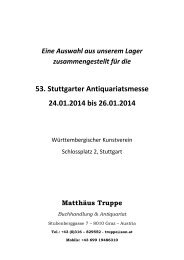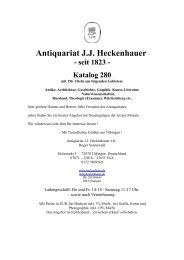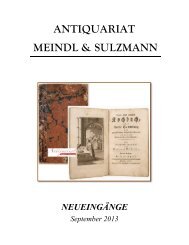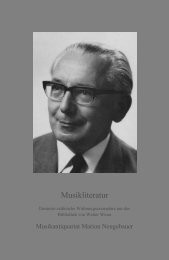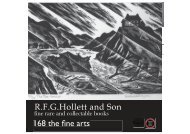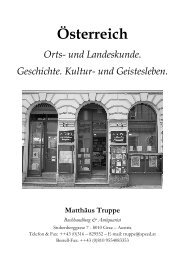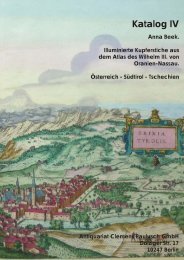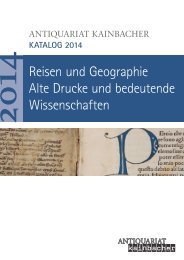Recent Acquisitions - Richard C. Ramer Old & Rare Books
Recent Acquisitions - Richard C. Ramer Old & Rare Books
Recent Acquisitions - Richard C. Ramer Old & Rare Books
You also want an ePaper? Increase the reach of your titles
YUMPU automatically turns print PDFs into web optimized ePapers that Google loves.
24<br />
richard c. ramer<br />
Apparently Unpublished Manuscript<br />
24. BORJA, Victor Profirio [or Porfirio] de, trans. M. Hilaire-Bernard<br />
de Requeleyne, Baron de Longepierre. “Medêa Tragedia de Longepierre.<br />
Traduzida em verso Portuguez.” Manuscript on paper. Ca. 1820? 4°, contemporary<br />
crimson straight-grained morocco (faint circular stain on<br />
front cover; minor wear at corners, occasionally elsewhere; single tiny<br />
round wormhole near head of spine, covers a bit warped), flat spine<br />
gilt with black leather lettering piece, covers with rich gilt borders and<br />
small gilt stylized wheel or floral vignette at center, edges of covers<br />
double-ruled in gilt, marbled endleaves, all text-block edges gilt. Ornaments<br />
and rules. Very attractive and clean. Internally in fine condition.<br />
Overall very good to fine. Stamp and stamped accession number of<br />
Dr. José Bayolo Pacheco de Amorim on front free endleaf verso. (5, 1<br />
blank), 38, (no. 39 [otherwise blank], 1 blank) ll. $2,000.00<br />
Manuscript copy of a five-act tragedy in rhymed verse. The translator, Victor Profirio<br />
de Borja, was a Portuguese actor who emigrated to Brazil in the early nineteenth century.<br />
Around 1815 he attempted to establish a rival to the Real Teatro São João (founded in<br />
1813), buying land for the purpose of building a theater in Rua Lavradio, Rio de Janeiro.<br />
He acted in Rio de Janeiro in the 1820s. It is not known if this translation of Medêa was<br />
staged in Rio de Janeiro at the time. According to Sacramento Blake, Borja published a<br />
small folio volume in Rio de Janeiro in 1824 titled Plano para a edificação de um teatro publico.<br />
He is considered a Brazilian by virtue of having been in Brazil and sworn allegiance to<br />
the 1824 Brazilian constitution.<br />
The first leaf contains a dedication to an “amigo”, including twelve lines of verse<br />
referring to the dedicatee in the familiar tense, signed by Borja. Apparently there was a leaf<br />
preceding this, presumably with the name of the dedicatee, which has been removed.<br />
Longepierre’s Médée was first published in 1694 and performed that year at the Théâtre<br />
de la rue des Fossés Saint-Germain, Paris. It is based somewhat, despite Longpierre’s<br />
denials, on Corneille’s version which had been published in 1639. With the exception of<br />
alterations to Act IV, in which the character Aegeus is eliminated and Medea’s reason for<br />
vengeance toward Jason is developed, the two versions are rather similar. In the preface<br />
Longepierre directly answers the accusation that he copied this work from Corneille.<br />
He says he is going back to the style of the ancients for drama: modern, frivolous style<br />
is inappropriate for tragedy. If his Medea is similar to Corneille’s, it’s because both of<br />
them use Seneca’s Medea as their starting point. He admires Corneille, he says, but this<br />
isn’t based on Corneille’s work.<br />
When Borja wrote his translation in the early nineteenth century, the Longepierre<br />
version was more popular than that of Corneille. Acted only sixteen times until 1728, the<br />
revival of the Longepierre play was greatly enhanced through the acting abilites of Mlle.<br />
Balicour in the leading role. It remained in the repertory for 90 years, being produced 146<br />
times, and was also parodied by Donique and Riccoboni in Italian, La Méchante femme,<br />
October 29, 1728, at the Theatre Italien. Both La Harpe and Voltaire (with reservations)<br />
preferred this version to Corneille’s.<br />
M. Hilaire-Bernard de Requeleyne, Baron de Longepierre (1659-1721), was a tutor<br />
to French princes and considered the finest booklover of his generation. His Greek was<br />
sufficient to publish translations of Anacreon, Sappho, Bion, and Moschus. Greatly<br />
interested in theater, he wrote Parallèle de Corneille et Racine, 1686. In addition to Médée,<br />
he composed Sésostris (1694) and Electre (1702).






